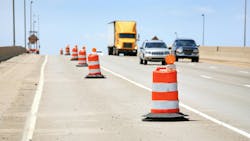AGC Survey Reveals Trends in Highway Work Zone Crashes
Nearly two-thirds of contractors reported vehicle crashes in highway work zones in the past year, and almost half say the risks are worse than a year ago, according to the 2025 Highway Work Zone Safety Survey released Tuesday by the Associated General Contractors of America.
The annual survey, conducted in partnership with construction software provider HCSS, found that 60% of highway contractors experienced at least one work zone crash involving a motorist in the last 12 months. Alarmingly, nearly one-third reported five or more crashes, and 24% said those incidents resulted in the death of a driver or passenger.
“Our data shows that too often, the motoring public lets workers down,” said Jeff Shoaf, CEO of AGC of America, in a video press conference on the survey. “Bad driving behavior and lax work zone safety laws don’t just put construction workers at risk—motorists are in even greater danger.”
While 30% of respondents reported injuries to construction workers, more than twice that (71%) said drivers or passengers were injured. Thirteen percent of contractors said a worker had been killed in a crash at one of their sites.
Shoaf called on Congress to require the National Highway Traffic Safety Administration to collect consistent data on work zone crashes and urged states to adopt tougher safety laws.
“We need to make work zone safety as much a priority as driving sober or buckling up,” he said.
Contractors emphasized that stronger enforcement and driver education are critical.
“Zero is the only acceptable outcome,” said Steve McGough, president of HCSS. “Educating people to put down their phones, slowing down in work zones, and using better technology can dramatically improve safety.”
Lane Felts, CEO of Texas-based Falt Co., recounted a harrowing incident in which one of his employees was struck by a drunk driver just hours after saving another person from suicide.
“It made me realize how dangerous this job is. We’ve got families too. We just want to go home at night like everyone else,” he said.
The risks are particularly high at night, Felts added, when workers are more likely to encounter impaired or fatigued drivers. “We’re putting a lot of faith in the public to do the right thing.”
Technology providers also pointed to digital solutions. Michael Gallant of HaulHub Technologies described a pilot program that uses equipment telematics to signal real-time work zone activity to apps like Waze.
“Drivers aren’t getting the message,” Gallant said. “But when they receive verified alerts like ‘workers are present now’—it changes behavior.”
AGC’s full report, national statistics and video testimonials are available at agc.org.
Source: Associated General Contractors
